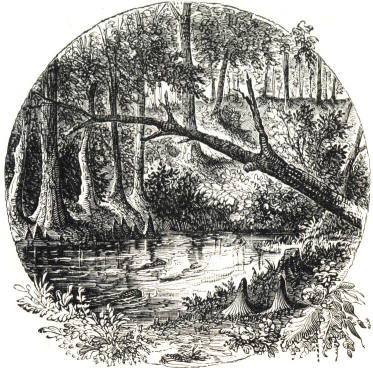Eutaw Springs
|
|
This Site:
|
It was near this spring that a severe battle was fought, September 8, 1781. Early in August, General Greene, on the High Hills of Santee, was reinforced by North Carolina troops under General Jethro Sumner; and at the close of that month he crossed the Wateree and Congaree and marched against the British camp at Orangeburg, commanded by Lieutenant - Colonel Stuart. Rawdon had left these troops in Stuart's charge and returned to England. Stuart, who had been joined by the garrison of Fort Ninety-six, immediately retreated, on the approach of Greene, to Eutaw Springs, 40 miles eastward, and there encamped. Greene pursued so stealthily that Stuart was not fully aware that the Americans were after him until they were close upon him, at dawn on the morning of September 8, 1781. Greene moved in two columns, the center of the first composed of North Carolina militia, with a battalion of South Carolina militia on each flank, commanded respectively by Marion and Pickens. The second consisted of North Carolina regulars, led by General Sumner, on the right; an equal number of Virginians, under Lieutenant-Colonel Campbell, in the center; and Marylanders, commanded by Colonel O. H. Williams, on the left. Lee's Legion covered the right flank, and Lieutenant-Colonel Henderson's troops covered the left. Washington's cavalry and Kirkwood's Delaware troops formed a reserve, and each line had artillery in front. Skirmishing began at eight o'clock in the morning. and very soon the conflict became general and severe. The British were defeated and driven from the field with much loss. The victory was complete, and the winners spread over the British camp eating, drinking, and plundering. Suddenly and unexpectedly the fugitives rallied and renewed the battle, and after a terrible conflict of about five hours, the Americans, who had lost heavily were compelled to give way. But Stuart, knowing that partisan legions were not far away, felt insecure, and that night, after breaking up 1,000 muskets and destroying stores, he retreated towards Charleston, pursued early the next morning (September 9) by parties who chased them far towards the sea. Although the battlefield remained with the Americans, neither party could fairly claim a victory. During the day and the pursuit the Americans lost in killed and wounded about 550 men; the British loss, including prisoners, was fully 800. Lieutenant-Colonel Washington was severely wounded in the second battle, and was made prisoner. For his good conduct on that occasion Congress presented to Greene its thanks, a gold medal, and a British standard taken in the fight. A few days after the battle, with a large number of sick soldiers, he retired with his troops to the Santee hills and encamped. There his militia left hint. He remained until the middle of November, when he marched his army into the low country, where he might obtain an abundance of food. The necessities of Greene's army had compelled him to go to the hills. The troops were too much exhausted to continue active operations. They were barefooted and half naked. He had no army hospital stores, very little salt, and his ammunition was very low. |
|
|
||
|
|
Site Copyright 2003-2018 Son of the South. For Questions or comments about this collection, contact: paul@sonofthesouth.net |
|
|
Are you Scared and Confused? Read My Snake Story, a story of hope and encouragement, to help you face your fears. |
||
 Eutaw
Springs, a place in
Eutaw
Springs, a place in